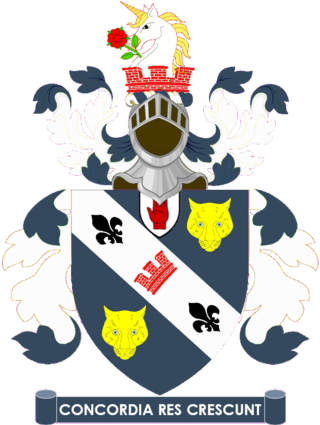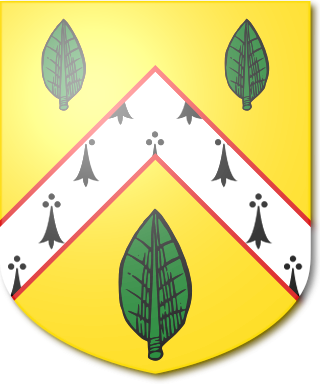
The Ainsworth Baronetcy, of Ardnanaiseig in the County of Argyll, is a title in the Baronetage of the United Kingdom. It was created on 12 January 1917 for the industrialist, banker and Liberal politician John Ainsworth.
The Adair Baronetcy, of Flixton Hall in the County of Suffolk, was a title in the Baronetage of the United Kingdom. It was created on 2 August 1838 for Robert Adair. He was succeeded by his eldest son, the second Baronet. He sat as Member of Parliament for Cambridge. In 1873 he was created Baron Waveney, of South Elmham in the County of Suffolk, in the Peerage of the United Kingdom. The barony became extinct on his death in 1886 while he was succeeded in the baronetcy by his younger brother, Hugh Adair, the third Baronet. The latter had earlier represented Ipswich in Parliament. Two of his sons, the fourth and fifth Baronets, both succeeded in the title. The fifth Baronet's son, the sixth Baronet, was a major general in the British Army. The title became extinct on the latter's death in 1988.
The Langham Baronetcy, of Cottesbrooke in the County of Northampton, is a title in the Baronetage of England. It was created on 7 June 1660 for John Langham, Member of Parliament for the City of London in 1654 and for Southwark in 1660 and 1661. The second Baronet was Member of Parliament for Northamptonshire and Northampton while the third Baronet sat for Northampton. The seventh Baronet was Member of Parliament for Northamptonshire. The tenth Baronet represented St Germans in the House of Commons. The thirteenth Baronet was a photographer, ornithologist and entomologist and served as High Sheriff of County Fermanagh in 1930.

The Bromhead Baronetcy, of Thurlby Hall in the County of Lincoln, is a title in the Baronetage of the United Kingdom. It was created on 19 February 1806 for the soldier Lieutenant-General Gonville Bromhead. His eldest son, the second Baronet, was a mathematician. He died unmarried and was succeeded by his younger brother, the third Baronet. He was a Major in the Army and fought at the Battle of Waterloo. His eldest son, the fourth Baronet, was a Colonel in the Indian Staff Corps. He was succeeded by his grandson, the fifth Baronet. He was a Lieutenant-Colonel in the Indian Army. As of 2007 the title is held by his son, the sixth Baronet, who succeeded in 1981. However he does not use his title.

The Couper Baronetcy is a title in the Baronetage of the United Kingdom. It was created on 23 June 1841 for George Couper. He was a colonel in the Army and fought in the Peninsular War, served as Military Secretary to the Governor Generals of Canada, Sir James Kempt and Lord Durham, and was Comptroller of the Household and Equerry to Her Royal Highness the Duchess of Kent. The second Baronet was an administrator in India and served as Governor of the North-West Provinces between 1877 and 1882. Another member of the family to gain distinction was James Kempt Couper, second son of the first Baronet. He was a general in the Army.
The Nepean Baronetcy, of Bothenhampton in the County of Dorset, was a title in the Baronetage of the United Kingdom. It was created on 16 July 1802 for the politician and colonial administrator Evan Nepean. He was Chief Secretary for Ireland from 1804 to 1805 and Governor of Bombay from 1812 to 1819. The title became extinct on the death of the sixth Baronet in 2002. Another member of the family to gain distinction was Herbert Evan Charles Bayley Nepean (1865–1951), son of Colonel Herbert Augustus Tierney Nepean, son of Reverend Evan Nepean, fourth son of the first Baronet. He was a Brigadier in the Indian Army. Lieutenant Colonel Evan Yorke Nepean, the 6th Baronet, was notable for having the amateur radio callsign AC4YN. With Hugh E. Richardson on a political mission to Tibet in 1936, he took this call based on his own initials and the AC4 prefix, which at that time was assigned to this country. It is famous as one of the rarest amateur stations.

The Synge Baronetcy, of Kiltrough in the County of Meath, is a title in the Baronetage of the United Kingdom. It was created on 12 August 1801 for Robert Synge. The third Baronet served as High Sheriff of County Cork in 1844. The family surname is pronounced "Sing". As of 28 February 2014 the present Baronet has not successfully proven his succession and is therefore not on the Official Roll of the Baronetage, with the baronetcy considered dormant since 2011.
The Goold Baronetcy, of Old Court in the County of Cork, is a title in the Baronetage of the United Kingdom. It was created on 8 August 1801 for Francis Goold, with remainder to the heirs male of his father Henry Michael Goold, who gave valuable service to the government of King George III. The Goold family descends from William Gould, who served as Mayor of Cork during the reign of King Henry VII. His descendant George Gould changed the spelling of the surname to Goold. He was the father of Henry Michael Goold and the grandfather of the first Baronet.

The Price, later Rugge-Price Baronetcy, of Spring Grove in Richmond in the County of Surrey, is a title in the Baronetage of the United Kingdom. It was created on 2 February 1804 for Charles Price, Member of Parliament for the City of London from 1802 to 1812 and Lord Mayor of London from 1802 to 1803. The fifth Baronet assumed in 1874 by Royal licence the additional surname of Rugge. As of 28 February 2014 the present Baronet has not successfully proven his succession and is therefore not on the Official Roll of the Baronetage, with the baronetcy considered dormant since 2000.

The Elton Baronetcy, of Bristol, is a title in the Baronetage of Great Britain. It was created on 31 October 1717 for Abraham Elton, Mayor of and Member of Parliament for Bristol from 1722 to 1727. The second Baronet was also Mayor of Bristol and represented Taunton and Bristol (1727–1742) in the House of Commons. The seventh Baronet sat as Liberal Member of Parliament for Bath. The eighth Baronet was High Sheriff of Somerset in 1895. The tenth Baronet was a pioneer of the British documentary film industry.

The Poore Baronetcy, of Rushall in the County of Wiltshire, is a dormant title in the Baronetage of Great Britain. It was created on 8 July 1795 for John Methuen Poore, with remainder, failing heirs male of his own, to his brother Edward Poore and the heirs male of his body.

The Milman Baronetcy, of Levaton-in-Woodland in the County of Devon, is a title in the Baronetage of Great Britain. It was created on 28 November 1800 for Francis Milman, Physician-in-Ordinary to King George III and President of the Royal College of Physicians. The seventh Baronet was a brigadier-general in the British Army.

The Grogan Baronetcy, of Moyvore in the County of Westmeath, was a title in the Baronetage of the United Kingdom. It was created on 23 April 1859 for the Irish politician Edward Grogan. His son, the second Baronet, was an officer in the British Army. The latter was childless and the title became extinct on his death in 1927.
The Palmer Baronetcy, of Castle Lackin in the County of Mayo, was created in the Baronetage of Ireland on 29 May 1777 for Roger Palmer. The fifth Baronet sat as Member of Parliament for County Mayo. The title became extinct on his death in 1910.

The Stewart baronetcy, of Ramelton in the County of Donegal, was created in the Baronetage of Ireland on 2 May 1623 for the soldier William Stewart.

The Lees Baronetcy, of Blackrock in the County of Dublin, was created in the Baronetage of the United Kingdom on 30 June 1804 for the soldier and politician John Lees.
The Ramsay baronetcy, of Balmain in the County of Kincardine, was created in the Baronetage of the United Kingdom on 13 May 1806 for Alexander Ramsay.

The Fraser Baronetcy, of Ledeclune in the County of Inverness, was created in the Baronetage of the United Kingdom on 27 November 1806 for William Fraser. The third Baronet served with the 7th Hussars in Spain during the Peninsular War, and was on the staff of the Duke of Wellington during the Waterloo Campaign. The fourth Baronet was an author and collector and also represented Barnstaple, Ludlow and Kidderminster in the House of Commons. The fifth Baronet sat as Member of Parliament for Harborough.

The Corbet baronetcy, of Moreton Corbet in the County of Shropshire and of Linslade in the County of Buckingham, was created in the Baronetage of the United Kingdom on 3 October 1828 for Andrew Corbet. He was a descendant of Richard Corbet of Shawbury, brother of Sir Vincent Corbet, 1st Baronet of the 1642 creation.

The Graham baronetcy, of Esk (Eske) in the County of Cumberland, was created in the Baronetage of England on 29 March 1629 for Richard Graham (c.1583–1654). He represented Carlisle in Parliament, was a Gentleman of the Horse to King Charles I and fought at the Battle of Edgehill in 1642.














